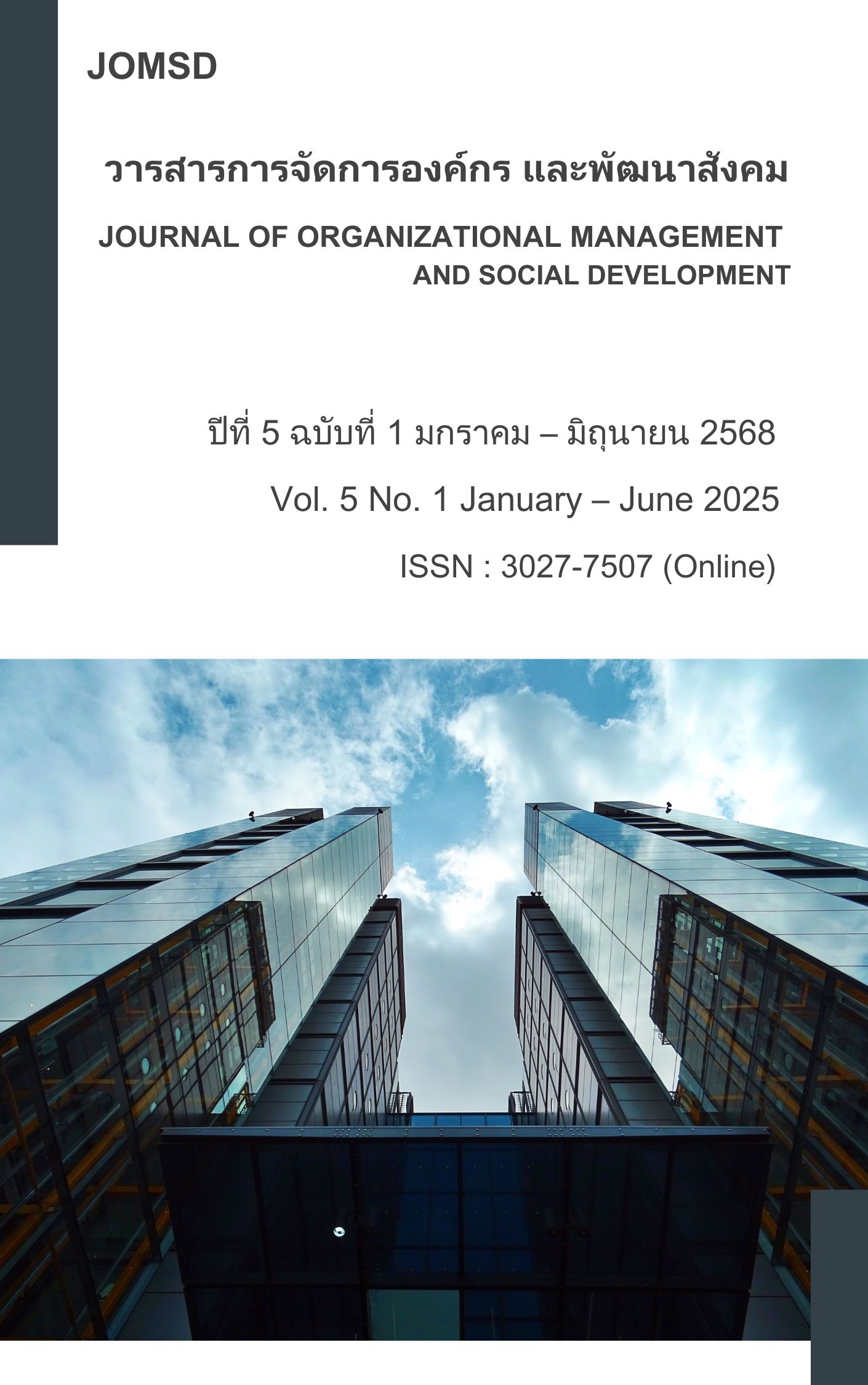Creating Cultural Tourism Routes of Wat Kamphaeng Bang Chak
Main Article Content
Abstract
This research aims 1) to examine the art forms present at the cultural tourism site of Wat Kamphaeng Bang Chak and 2) to develop a cultural tourism route centered around Wat Kamphaeng Bang Chak. This is a qualitative study employing in-depth interviews with 12 interviewees, including temple authorities, local community leaders, and business operators in the vicinity. The participants consist of the abbot, deputy abbot, resident monks with expertise in traditional Thai art and temple history, as well as community leaders and local vendors. The researcher employed purposive sampling and used semi-structured interview protocols as the primary research instrument. The data were analyzed, interpreted, and synthesized accordingly. The findings reveal the following: 1) The art forms at Wat Kamphaeng Bang Chak represent diverse artistic disciplines that are prominently displayed within the temple grounds. These works of art are of great historical and cultural value, reflecting the prosperity of the area from the late Ayutthaya period through the early Rattanakosin era. The artistic heritage that holds potential to enhance tourism appeal includes architecture, mural painting, and sculpture. 2) The proposed cultural tourism route was designed based on principles of meaningful and value-based tourism, encouraging visitors to engage in immersive and culturally rich experiences. Key highlights of the route include paying homage to Luang Pho Bussarakam, viewing traditional Thai fine arts, exploring local life at the Khlong Bang Luang Community Museum, discovering vintage toys at the Toy House, enjoying contemporary art at the Artist’s House, creating personal artworks at Ban Phueng Silpa (Art Creation House), taking a long-tail boat ride to appreciate the canal-side lifestyle, and tasting traditional Thai cuisine.
Article Details
References
กรมการท่องเที่ยว. (2562). แนวทางการส่งเสริมการท่องเที่ยวเชิงวัฒนธรรม. กรุงเทพฯ: กรมการท่องเที่ยว.
กระทรวงการท่องเที่ยวและกีฬา. (2567). รายงานสถานการณ์การท่องเที่ยวกรุงเทพมหานคร ช่วงเดือนมกราคม-มีนาคม พ.ศ. 2567. กรุงเทพฯ: กระทรวงการท่องเที่ยวและกีฬา.
กุลแก้ว คล้ายแก้ว และคณิต เขียววิชัย. (2566). เมืองมรดกโลกกับอัตลักษณ์ทางวัฒนธรรมเพื่อการท่องเที่ยว กรณีศึกษา พื้นที่ตำบลเมืองเก่า จังหวัดสุโขทัย. วารสารสังคมศาสตร์ปัญญาพัฒน์, 5(2), 25-40.
ชณัฎฐ์ พงศ์ธราธิก, สุมนรตรี นิ่มเนติพันธ์ และอนันต์ มาลารัตน์. (2564). การพัฒนากลยุทธ์การท่องเที่ยวเชิงวัฒนธรรมในจังหวัดประจวบคีรีขันธ์. วารสาร มจร พุทธปัญญาปริทรรศน์, 6(3), 77-91.
แน่งน้อย ศักดิ์ศรี, ไขแสง ศุขะวัฒนะ และผุสดี ทิพทัส. (2531). สถาปัตยกรรมพระบรมราชวัง เล่ม 2. กรุงเทพฯ: โรงพิมพ์กรุงเทพฯ.
ประพล จิตคติ. (2564). การพัฒนาเส้นทางการท่องเที่ยวอุทยานประวัติศาสตร์ในเขตภาคเหนือตอนล่างของประเทศไทย. วารสารศิลปการจัดการ, 5(1), 73-86.
ประภัสสร์ ชูวิเชียร. (2560). อยุธยาในย่านกรุงเทพฯ. กรุงเทพฯ: มติชน.
ประสพชัย พสุนนท์, ธีระวัฒน์ จันทึก, มนัสสินี บุญมีศรีสง่า, ปริญญา หรุ่นโพธิ์, ธงชัย ทองมา และปัทมา วัฒนบุญญา. (2562). แนวทางการส่งเสริมการท่องเที่ยวทางวัฒนธรรมไทย-จีน ในย่านฝั่งธนบุรี เพื่อการท่องเที่ยวเชิงสร้างสรรค์. สืบค้นจาก https://shorturl.asia/KDI6U.
รสสุคนธ์ ประดิษฐ์ และยุวดี พ่วงรอด. (2567). ศักยภาพและโอกาสในการพัฒนาการท่องเที่ยวชุมชนตามตำนานท้องถิ่น ตำนานพระร่วง อำเภอศรีสัชนาลัย จังหวัดสุโขทัย. วารสารสังคมศาสตร์ปัญญาพัฒน์, 6(1), 77-88.
วรพงศ์ ผูกภู่. (2564). การพัฒนาชุมชนท่องเที่ยวเชิงวัฒนธรรมกับเป้าหมายการพัฒนาที่ยั่งยืน (SDGs). กรุงเทพฯ: กรมส่งเสริมวัฒนธรรม.
วิรินทร์ วิริยะพาณิชย์. (2549). วัดกำแพง(คลองบางจาก): สถาปัตยกรรมและวิเคราะห์จิตรกรรมฝาผนัง. กรุงเทพฯ: มหาวิทยาลัยศิลปากร.
ศิลาวัฒน์ ชัยวงศ์, พระครูสังฆรักษ์ศุภณัฐ ภูริวฑฺฒโน, พระครูสุตชยาภรณ์, พระมหาบวรวิทย์ อายุมั่น และสุทธิพร สายทอง. (2564). การพัฒนาเส้นทางการท่องเที่ยวเชิงศิลปะของกลุ่มจังหวัดล้านนา. วารสารบัณฑิตศึกษาปริทรรศน์ มจร วิทยาเขตแพร่, 7(1), 75-89.
ศูนย์วิจัยกสิกรไทย. (2565). การท่องเที่ยวเชิงวัฒนธรรม: โอกาสเติบโตท่ามกลางกระแสการท่องเที่ยววิถีใหม่. กรุงเทพฯ: ศูนย์วิจัยกสิกรไทย.
สำนักงานประชาสัมพันธ์จังหวัดราชบุรี. (2567). Soft Power (5F) ไทยดึงดูดใจนักท่องเที่ยว. สืบค้นจาก https://shorturl.asia/k9TqX.
สุรภัทร์ พิไชยแพทย์ และกนกอร เนตรชู. (2567). การพัฒนาเส้นทางการท่องเที่ยวย่านชุมชนเมืองเก่าริมแม่น้ำเพชรบุรีที่มุ่งเน้นการท่องเที่ยวเชิงประวัติศาสตร์และศิลปวัฒนธรรมเพื่อยกระดับจังหวัดเพชรบุรีสู่เมืองสร้างสรรค์. วารสารการเมือง การบริหาร และกฎหมาย, 16(1), 182-199.
Bangkok Post. (2024, April 19). Kingdom of Thailand welcomed 35m tourists in 2024 (Bangkok Post). Retrieved from https://www.bangkokpost.com/thailand/general/2931152/kingdom-of-thailand-welcomed-35m-in-2024.

